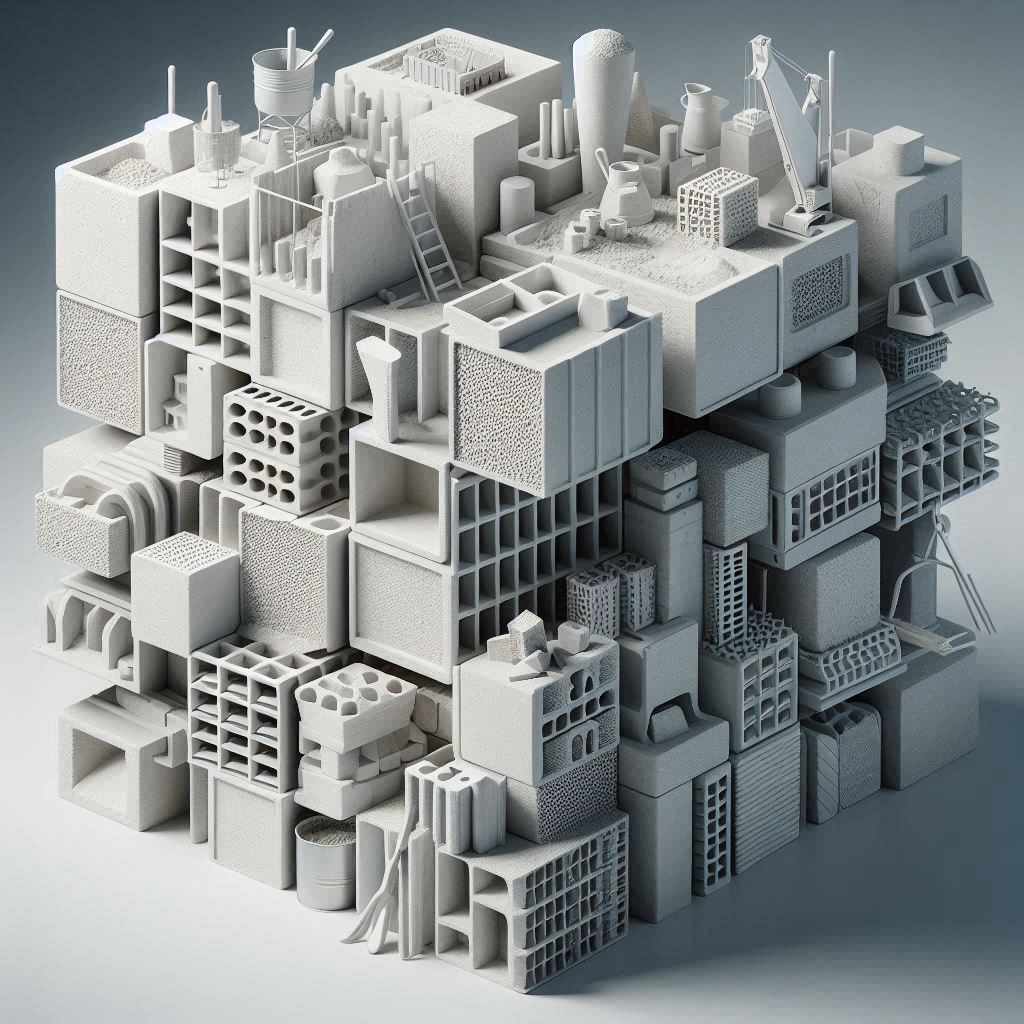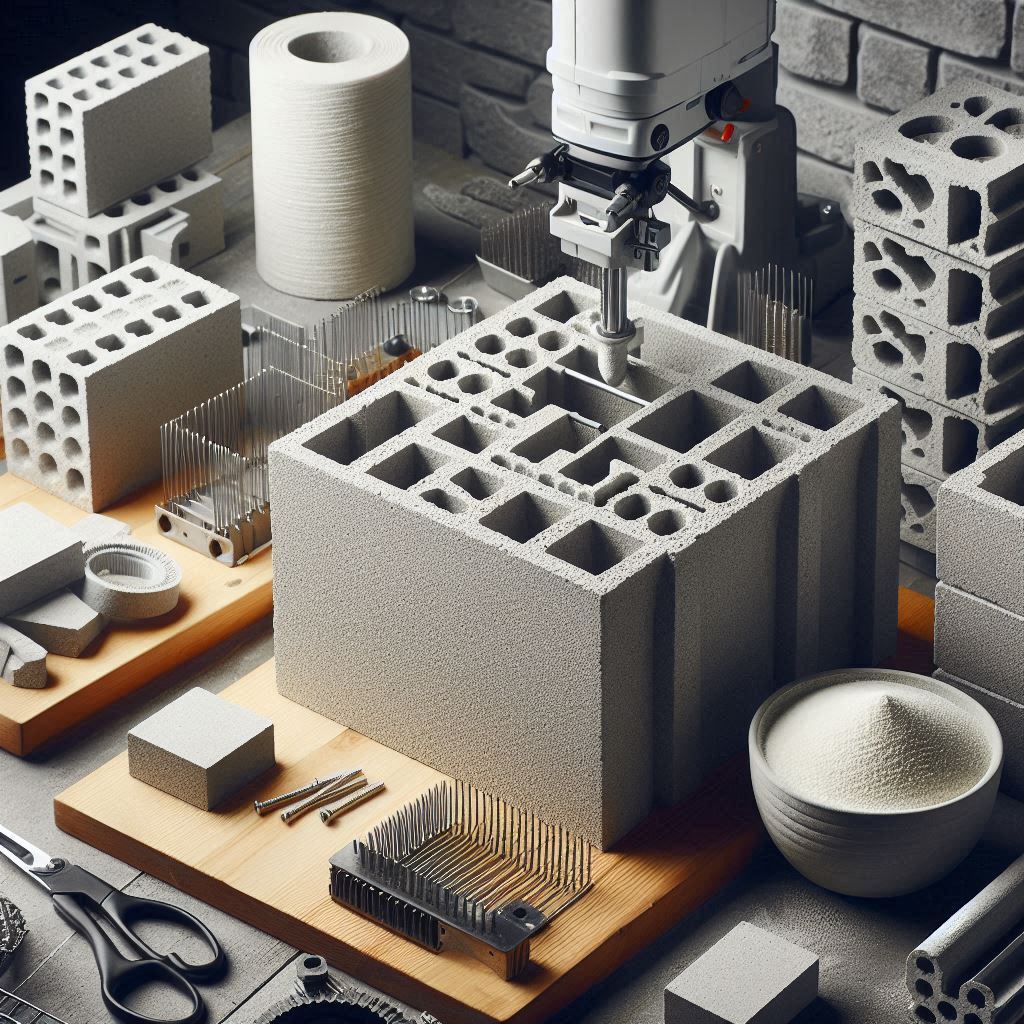What are aerated concrete blocks?
Aerated concrete is a type of porous concrete. This building material of artificial origin is produced by adding special gas-forming agents to the cement-sand mixture. Due to thorough mixing, after the solution is prepared, spherical pores with a diameter of 1-3 mm begin to form in its volume. Due to the communication with each other, an increase in thermal insulation and strength of the blocks is achieved simultaneously. Some types of gas block can add ash, lime, slag, gas block production waste, gypsum and other fillers. Fine aluminum dust is usually used as a foaming agent. After entering an alkaline environment, a chemical reaction occurs with the formation of gas (hydrogen), the solution “foams”, and aluminum turns into calcium aluminum. Various pastes and suspensions based on metal dust can be used to increase the efficiency of foaming and reduce the consumption of valuable aluminum.

What are aerated concrete blocks made of?
A typical production cycle consists of the following sequence::
- Delivery of sand, water, foaming agents and fillers to the production site;
- Mixing dry ingredients;
- Adding water in proportions by technology;
- Adding foaming agent;
- Pouring the solution into large-sized molds.

An alkaline reaction occurs, the solution is compacted, and the active release of small hydrogen bubbles begins. Preliminary setting is expected. For convenience and lower production costs, large blocks are cut by special mechanisms (cutters, saws, strings, blades) to the size of the final product. After that, the block cut into segments is delivered to the autoclave hardening chamber, where the block is exposed to high-temperature water vapor. After autoclave hardening, the blocks are dried in special chambers with moisture removal.
Characteristics of aerated concrete blocks
Properties and characteristics of the gas unit are specified in the following standards:
- GOST 25485-89, 21520-89, 31359-2007, 313360-2007;
- SNiP 277-80.
The standard size of a gas block for masonry exterior walls is 500-600 mm long, 200 mm high and 400 mm wide. The technical characteristics of such a block depend on its production technology and brand. The average values can be something like this:
- Wall area from 1 m3 – 2.5 m2;
- Pallet weight for D400-950 kg;
- Number of blocks of 1 m3-20.83;
- Weight of 1 unit-26.3 kg;
- Frost resistance-F100;
- Compressive strength-2.78 MPa;
- Freeze / thaw cycles-50;
- Shrinkage strain – 0.46 mm / m;
- Thermal conductivity – 0.096 W/m*s.

Very much in the technical characteristics depends on the average density (brand).
Types of aerated concrete blocks
The gas block differs in a number of criteria:
- Dimensions (thickness / height / length);
- Scope of application-wall, partition;
- Density-D300-D800 and higher. Most often used in private housing construction D400-500;
- Block shape-with groove-ridge connection, flat sides, U-blocks, reinforced blocks, hollow blocks;
- Depending on the binder component and the gas-forming agent used (lime, slag, cement, ash, combined);
- The presence of an autoclave hardening stage according to the production technology-a gas block of autoclave hardening (synthesis hardening) and without it (non-autoclave, hydration).
Very often the gas block is confused with another very similar type of cellular concrete-foam block. Despite the external similarity, these materials are very different both in production technology and in their properties. So, the foam block is obtained by adding ready-made whipped foam to the cement-sand mortar, while the gas block “rises” during a chemical reaction.
Dimensions of aerated concrete blocks
The scope of application of a gas block is largely determined by its size. Wall blocks can have a thickness of 75 mm in width, while wall blocks can have a thickness of up to 600 mm. Brands used:
- D350-low density does not allow the use of such material as a load-bearing structure, so it is usually used as insulation to save heat carriers. Quite fragile, very light and pliable material. Rarely seen on construction sites due to the popularity of the D400-D500;
- D400-when a number of conditions are met, it can be used as a load-bearing material with high thermal insulation, but insufficient strength. It is often used for sealing openings, external insulation, and the construction of single-story utility buildings;
- D500 is the main brand for single-storey and multi-storey buildings. At high density, it has relatively high thermal insulation properties;
- D600-a more expensive analog, with reduced thermal insulation, but with increased strength.
The size and density of blocks should be determined by the design documentation as a result of performing calculations. In addition, the gas block is a plastic material, it can easily be cut with a regular hacksaw, planed with special graters and processed with a hand tool.
Advantages of aerated concrete blocks
Today aerated concrete blocks are used everywhere in such types of construction:
- Low-rise buildings-Cottage houses, garages, outbuildings, warehouses;
- insulation inside or outside premises (buildings);
- Bookmark openings, piers, change the layout;
- Construction of load-bearing structures, supports;
- Construction of monolithic high-rise buildings (laying walls between load-bearing monolithic beams);
- Construction of frame houses.

Since the gas block is made from natural materials, it is safe, has a relatively low cost, and is easily manufactured without large investments. Advantages over brick (as the closest competitor in the field of construction):
- Low weight-it makes it easier to work with the material, you don’t need a “heavy” foundation, so the building owners can save on construction costs.;
- Low thermal conductivity (high thermal insulation properties) – 4 times lower than ceramic bricks, 9.5 times lower than silicate bricks, 2 times lower than large-format ceramic blocks;
- Fire safety – do not support burning;
- Low cost of the finished wall-20-30% cheaper to use a gas block than a ceramic brick;
- Relatively low labor costs;
- Easy to process.
The D500 density gas block can simultaneously play the role of both a load-bearing material and a heater, while brick walls, due to their high thermal conductivity, need additional insulation over the entire surface. The technology of production of aerated concrete blocks has significantly improved recently. Today, the blocks are manufactured on fully automated lines, with laboratories for quality control of incoming raw materials and finished products. With other building materials (cinder block, seashell, silicate bricks, ceramic, expanded clay blocks), things are much worse. It is very difficult to find high-quality building materials at an affordable price, while high competition and aerated concrete production technology provide for high quality finished products with minimal deviations from the reference dimensions.